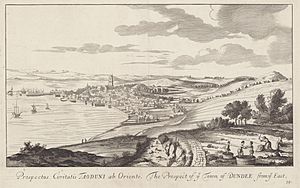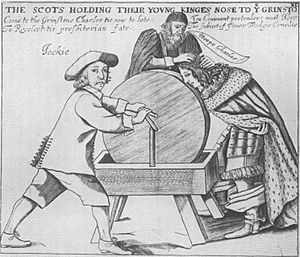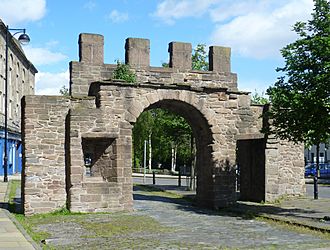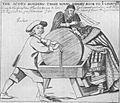Siege of Dundee facts for kids
Quick facts for kids Siege of Dundee |
|||||||
|---|---|---|---|---|---|---|---|
| Part of Wars of the Three Kingdoms | |||||||
 Engraving of Dundee, c. 1693 |
|||||||
|
|||||||
| Belligerents | |||||||
| Commanders and leaders | |||||||
| Robert Lumsden † | George Monck | ||||||
| Strength | |||||||
| 500 or more | Unknown | ||||||
| Casualties and losses | |||||||
| 100–1,000 killed, including some civilians 200 captured |
Unknown | ||||||
The Siege of Dundee happened from August 23 to September 1, 1651. It was part of the war between England and Scotland (1650–1652). English forces, led by George Monck, attacked the Scottish town of Dundee. The town's defenders were commanded by Robert Lumsden. After two days of heavy cannon fire, the English captured Dundee on September 1. The town was then looted. Between 100 and 500 people were killed, including Governor Lumsden.
Soon after, the city of Aberdeen also gave up. This meant that most of the fighting in Scotland ended. At the same time, Oliver Cromwell won a big battle at Worcester in England. This battle finished the Wars of the Three Kingdoms. The Scottish government, led by the Covenanters, was then dissolved. Scotland became part of the English Commonwealth. It stayed that way until the King returned to power in 1660.
Contents
Why the Siege Happened
Religious Changes and Early Conflicts
King Charles I wanted to make changes to the Church of Scotland. These changes led to wars in 1639 and 1640, known as the Bishops' Wars. Charles I lost these wars. This led to a new Scottish government, run by a group called the Covenanters. Charles I also had to call the Parliament of England back into session in November 1640.
Things got worse between the King and the English Parliament. This led to the start of the First English Civil War in August 1642. In England, the King's supporters, called Royalists, fought against Parliament's supporters, called Parliamentarians. The Parliamentarians had an agreement with Scotland from 1643. It was called the Solemn League and Covenant.
In 1646, King Charles I gave himself up to the Scots. He hoped they would give him better terms than the English Parliament. After many talks that went nowhere, the Scots handed him over to Parliament. They received money for this. Their soldiers went home in February 1647.
King Charles I's Execution
King Charles I was very stubborn. Fighting started again in 1648 during the Second English Civil War. Leaders of England's main army, the New Model Army, decided to put the King on trial for treason. To do this, they removed Members of Parliament who were against the trial in December 1648. This smaller group of MPs then approved the Execution of Charles I on January 30, 1649. This created a new government in England called the Commonwealth, which was a republic without a king.
The Scottish Covenanter government was not asked about the King's execution. They immediately declared Charles I's son, Charles II, as the new King of Britain. At first, Charles II didn't want Scottish help. But after his supporters in Ireland were defeated, he agreed to the Scots' terms in 1650. These terms included a promise to help him get the English throne back. The Scots began to gather an army for this, led by the skilled general David Leslie.
England Invades Scotland
The English Commonwealth reacted by sending Oliver Cromwell to attack Scotland first. On July 22, 1650, parts of the New Model Army crossed the Tweed into Scotland. This started the war between England and Scotland (1650–1652). Cromwell tried to get the Scots to fight near Edinburgh, but Leslie avoided battle. On August 31, the English army went back to Dunbar.
Leslie thought Cromwell's army was trapped at Dunbar. He felt pressured to finish them off. So, he prepared to attack Dunbar. But in the early morning of September 3, Cromwell launched a surprise attack on the Scottish army. The Battle of Dunbar was very close. Cromwell himself led his cavalry in a surprise attack. This broke the Scottish lines. Leslie's army retreated, but out of 12,000 soldiers, about 1,500 were killed or hurt. Another 6,000 were captured.
Leslie tried to gather his remaining army and build new defenses at Stirling. Stirling was a narrow passage that blocked the way to north-east Scotland. This area was important for supplies and new soldiers for the Scots. Many government leaders, clergy, and important people from Edinburgh joined him there. On January 1, 1651, Charles II was officially crowned King at Scone.
After six months of planning, an English force of 1,600 men, led by Colonel Robert Overton, crossed the Firth of Forth. They landed near Inverkeithing on July 17. On July 20, the Scots, with over 4,000 men led by Major-general James Holborne, attacked the English. The English now had about 4,000 men, led by Major-general John Lambert. In the Battle of Inverkeithing, the Scottish cavalry were defeated. When the Scottish foot soldiers tried to retreat, many were killed as the English chased them.
The Road to Dundee
After the Battle of Inverkeithing, Lambert marched about 6 miles (10 km) east. He took control of the port of Burntisland. Cromwell then moved most of the English army there. Cromwell realized this left the way open for the Scots to invade England. He made plans for what to do if that happened. Then, he ignored the Scottish army at Stirling. On July 31, he marched to Perth, where the Scottish government was located. He surrounded the city. Perth gave up after two days. This cut off the Scottish army from new soldiers, food, and supplies.
In desperation, Charles II and Leslie decided their only chance was to invade England. They hoped people in England would support the King. So, they took their army south. Cromwell and Lambert followed them closely. Cromwell left General George Monck with over 5,000 less experienced soldiers. Monck's job was to finish off any remaining Scottish resistance.
Monck marched to Stirling and arrived on August 6. The town surrendered. After being heavily shelled by English cannons, Stirling Castle also gave up on August 14. Monck sent 1,400 men under Colonel John Okey to take control of western Scotland. Monck then marched back through Perth towards Dundee. Dundee was one of the last three important Scottish strongholds still holding out. The others were Aberdeen and St Andrews.
The Siege and Attack
Dundee was a walled town, but its defenses were old, some from the 1500s. The town had been easily captured by a Royalist force in 1645. Still, because it had walls and a garrison of at least 500 men, many Scots put their money and valuables there. They hoped to keep them safe from the English. The town was full of Scots who had fled from the English, some from as far away as Edinburgh.
Monck brought his army outside Dundee on August 23. He demanded that the town surrender. The town's governor, Robert Lumsden, believed the walls and local fighters were strong enough. So, he refused to give up.
When the Scottish Parliament was not meeting, a group called the Committee of Estates held power. After Cromwell captured Perth, this group tried to gather a new army in Angus. On August 28, an English cavalry group, led by Colonel Matthew Alured, surprised 5,000 Scots at Alyth. This was about 15 miles (24 km) north of Dundee. The Scots were scattered, and all the members of the Committee of Estates were captured. On August 30, St Andrews also surrendered.
Bad weather delayed the English cannons from firing on Dundee. On August 30, the weather cleared. Monck again told Governor Lumsden to surrender the town. Again, Lumsden refused. Monck was angry that he had to risk his soldiers' lives when the war was almost over. He gave permission for the town to be looted once it was captured.
Two days after their cannons started firing, the English attacked the west and east gates on the morning of September 1. By noon, they had broken into the town. They then thoroughly looted it. Several hundred civilians, including women and children, were killed, as was Governor Lumsden. Monck said 500 Scots were killed. Today, estimates range from 100 to as many as 1,000. About 200 prisoners were taken. Monck allowed his army 24 hours to take whatever they wanted. A lot of valuable items were taken. Some soldiers became very rich.
Since the town had refused to surrender peacefully and was taken by force, these actions were not against the rules of war at that time. However, they were seen as unusually harsh. After the looting, the New Model Army's strict discipline was put back in place. Dundee took over a century to recover from the economic damage of the attack.
What Happened Next
Soon after Dundee was captured, Aberdeen surrendered. Its leaders saw no point in fighting a losing battle. A few isolated strongholds, like the Bass Rock, Dumbarton Castle, and Dunnottar Castle near Stonehaven, held out until 1652. But English forces could go as far north as Orkney without much resistance.
Meanwhile, the Scottish army under Charles II and Leslie had gone into England. They reached Worcester. There, the stronger English army, which was better trained and supplied, cut off the Scots' escape route. On September 3, two days after Dundee was stormed, the English attacked. They completely defeated the Scots. Charles II was one of the few who managed to escape capture.
The Battle of Worcester marked the end of the Wars of the Three Kingdoms. The defeated Scottish Government was dissolved. The English Commonwealth took Scotland into its control. Military rule was put in place. 10,000 English soldiers were stationed across Scotland to stop any uprisings. Talks began to officially combine Scottish laws and politics into the new British state. By 1653, two Scottish representatives were invited to join the English Parliament.
In 1660, Monck, who was now in charge of Scotland, marched his army south. He entered London and called for new elections for Parliament. This new Parliament declared on May 8, 1660, that Charles II had been the rightful king since his father's execution. Charles II returned from exile. He was crowned King of England on April 23, 1661. This completed the return of the monarchy, known as the Restoration.
Sources
Images for kids






